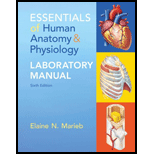
Essentials of Human Anatomy & Physiology Laboratory Manual (6th Edition)
6th Edition
ISBN: 9780321947918
Author: Elaine N. Marieb
Publisher: PEARSON
expand_more
expand_more
format_list_bulleted
Textbook Question
Chapter 2, Problem 38SAE
Explain why you can “stack” water slightly above the rim of a glass if you pour the water in very carefully.
Expert Solution & Answer
Want to see the full answer?
Check out a sample textbook solution
Students have asked these similar questions
State the five functions of Globular Proteins, and give an example of a protein for each function.
Diagram of check cell under low power and high power
a couple in which the father has the a blood type and the mother has the o blood type produce an offspring with the o blood type, how does this happen? how could two functionally O parents produce an offspring that has the a blood type?
Chapter 2 Solutions
Essentials of Human Anatomy & Physiology Laboratory Manual (6th Edition)
Ch. 2 - Prob. 1MCCh. 2 - Prob. 2MCCh. 2 - Prob. 3MCCh. 2 - Prob. 4MCCh. 2 - Glucose is to starch as a. a steroid is to a...Ch. 2 - 6. What lipid type is stored in fat deposits...Ch. 2 - Absence of which of the following...Ch. 2 - ATP is not associated with a. a basic nucleotide...Ch. 2 - Prob. 9MCCh. 2 - 10. Factors that increase the speed of chemical...
Ch. 2 - Why is a study of basic chemistry essential to...Ch. 2 - Matter occupies space and has mass. Explain how...Ch. 2 - Prob. 13SAECh. 2 - Prob. 14SAECh. 2 - Prob. 15SAECh. 2 - Prob. 16SAECh. 2 - All atoms are neutral. Explain the basis of this...Ch. 2 - Fill in the following table to fully describe an...Ch. 2 - Define radioactivity. If an element has three...Ch. 2 - Prob. 20SAECh. 2 - Prob. 21SAECh. 2 - Where would you expect to Find hydrogen bonds in...Ch. 2 - The two oxygen atoms forming molecules of oxygen...Ch. 2 - Prob. 24SAECh. 2 - 25. Identify each of the following reactions as a...Ch. 2 - Prob. 26SAECh. 2 - Prob. 27SAECh. 2 - 28. Define pH. The pH range of blood is from 7.35...Ch. 2 - Prob. 29SAECh. 2 - Prob. 30SAECh. 2 - Describe the structural differences between...Ch. 2 - Prob. 32SAECh. 2 - 33. Name the two protein classes based on...Ch. 2 - Prob. 34SAECh. 2 - Describe what has happened to a proteins structure...Ch. 2 - Prob. 36SAECh. 2 - Prob. 37SAECh. 2 - 38. Explain why you can “stack” water slightly...Ch. 2 - Explain what is meant by the terms synthesis...Ch. 2 - 41. Several antibiotics act by binding to certain...Ch. 2 - 42. Mrs. Roberts, who is in a diabetic coma, has...Ch. 2 - Tendons, ligaments, and skin contain a large...Ch. 2 - Prob. 43CAQ
Knowledge Booster
Learn more about
Need a deep-dive on the concept behind this application? Look no further. Learn more about this topic, biology and related others by exploring similar questions and additional content below.Similar questions
- What is the opening indicated by the pointer? (leaf x.s.) stomate guard cell lenticel intercellular space none of thesearrow_forwardIdentify the indicated tissue? (stem x.s.) parenchyma collenchyma sclerenchyma ○ xylem ○ phloem none of thesearrow_forwardWhere did this structure originate from? (Salix branch root) epidermis cortex endodermis pericycle vascular cylinderarrow_forward
- Identify the indicated tissue. (Tilia stem x.s.) parenchyma collenchyma sclerenchyma xylem phloem none of thesearrow_forwardIdentify the indicated structure. (Cucurbita stem l.s.) pit lenticel stomate tendril none of thesearrow_forwardIdentify the specific cell? (Zebrina leaf peel) vessel element sieve element companion cell tracheid guard cell subsidiary cell none of thesearrow_forward
- What type of cells flank the opening on either side? (leaf x.s.) vessel elements sieve elements companion cells tracheids guard cells none of thesearrow_forwardWhat specific cell is indicated. (Cucurbita stem I.s.) vessel element sieve element O companion cell tracheid guard cell none of thesearrow_forwardWhat specific cell is indicated? (Aristolochia stem x.s.) vessel element sieve element ○ companion cell O O O O O tracheid O guard cell none of thesearrow_forward
- Identify the tissue. parenchyma collenchyma sclerenchyma ○ xylem O phloem O none of thesearrow_forwardPlease answer q3arrow_forwardRespond to the following in a minimum of 175 words: How might CRISPR-Cas 9 be used in research or, eventually, therapeutically in patients? What are some potential ethical issues associated with using this technology? Do the advantages of using this technology outweigh the disadvantages (or vice versa)? Explain your position.arrow_forward
arrow_back_ios
SEE MORE QUESTIONS
arrow_forward_ios
Recommended textbooks for you






GCSE Chemistry - Acids and Bases #34; Author: Cognito;https://www.youtube.com/watch?v=vt8fB3MFzLk;License: Standard youtube license